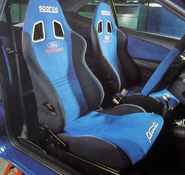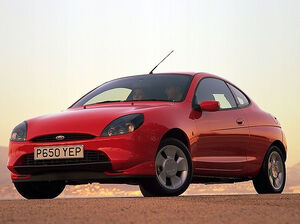
| |
| Ford Puma | |
|---|---|
| Ford | |
| aka | |
| Production | 1997–2002 |
| Class | Sport compact |
| Body Style | 3-door 2+2 hatchback coupé |
| Length | 3,984 mm (156.9 in) |
| Width | 1,837 mm (72.3 in) |
| Height | 1,315 mm (51.8 in) |
| Wheelbase | 2,446 mm (96.3 in) |
| Weight | {{{Weight - you get the point}}} |
| Transmission | 5-speed IB5 manual |
| Engine | |
| Assembly | Cologne, Germany |
| Layout | Front-engine, front-wheel drive |
| Designer | |
This article is about the sport compact. For subcompact crossover, see Ford Puma (2020).
The Ford Puma is a small three-door coupé that was produced by Ford Europe from September 1997 to July 2002. The Puma was built exclusively at Ford's Niehl plant in Cologne, Germany. The Ford Puma follows common design cues with other Ford cars at the time, and is in the New Edge family of vehicles.
See Autopedia's comprehensive Ford Puma Review.
Recent Changes
Mention any minor facelifts or major changes made to the vehicle here.
Styles and Major Options
Certain vehicles come in different trim levels or body styles. Features and major options should be mentioned here.
Pricing
Add more fields as necessary.
|
MODEL Trims |
|||
|
Trim1 |
Trim2 |
Trim3 |
Trim4 |
|
MSRP |
|||
|
$Price1 |
$Price2 |
$Price3 |
$Price4 |
|
Invoice |
|||
|
$Price1 |
$Price2 |
$Price3 |
$Price4 |
Gas Mileage
Add more fields as necessary.
As seen on the FuelEconomy.gov website, the City/Highway MPG averages are as follows:
|
Trim |
|||
|
Trim1 |
Trim2 |
Trim3 |
Trim4 |
|
MPG |
|||
|
c/h |
c/h |
c/h |
c/h |
Reliability
Warranty options and scheduled maintainence information should be mentioned here.
Safety
This section should reference points on safety ratings and features of the vehicle.
Photos
Add Photos of the vehicle here.
Please make sure not to use copyrighted photos.
Colors
List the colors that the particular <MODEL> is offered in.
Main Competitors
Create links to other <MAKE> <MODEL> pages in this section.
Hybrid Models
If there are hybrid versions of this vehicle manufactured, then please elaborate a little bit on it here.
Unique Attributes
Stylistically, the Puma followed Ford's New Edge design strategy, as first seen in the 1996 Ford Ka. While not as controversial as the Ka when it first appeared, the Puma did achieve critical acclaim for its well-proportioned and cat-like design cues.
Technical details
All Pumas are front-engined, front-wheel-drive, three-door coupés with four seats. They came with 15-inch (380 mm) alloy wheels as standard, (although the Ford Racing Puma was equipped with 17-inch (430 mm) alloy wheels), with front disc and rear drum brakes. The car was based on the Mark 4 Ford Fiesta, with new engines (codeveloped with Yamaha), a new body, stiffer suspension, wider track and close-ratio gearbox, among other changes.
The Puma was available with four engine options: 1.4-litre (1997-2000), 1.6-litre (2000-2001), 1.7-litre VCT (only used in the Puma), and the Tickford-tuned 1.7-litre VCT (which was only used in the Ford Racing Puma),[1] each of which used Ford's 16-v Sigma engines branded as Zetec-SE. Additionally, the 1.7-litre engines used Nikasil cylinder plating, which required a specific grade of oil (5W30 semisynthetic) to minimise mechanical wear.
The production journey of the 1.7-litre VCT was quite interesting. Rough machined cylinder blocks were shipped from Ford's Valencia plant in Spain to Yamaha in Japan for Nikasil coating and completion. These were then shipped back to Ford's Cologne plant where the Puma was assembled.[2]
All 1.7-litre-engined Pumas were equipped with low-speed traction control and antilock brakes. The antilock braking system was optional in the 1.4-litre Puma.
During the relatively short production run, about 133,000 Pumas were built (all models including the Ford Racing Puma). At its peak, 52,950 were registered with the DVLA in the UK, which has since reduced to 8,445 (including 5,550 that have statutory off-road notification (SORN)) as of Q3 2021.[3]
Resale Values
Add more fields as necessary.
|
<MODEL> Year |
|||
|
Year X |
Year X-2 |
Year X-3 |
Year X-4 |
|
Resale Value |
|||
|
$ |
$ |
$ |
$ |
Criticisms
Please make sure to keep critiques in a third-person point of view. If using criticisms from a reputable automotive source, then please make sure to cite the quote.
Interior
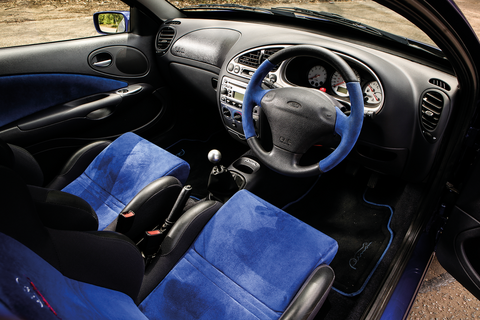
Sparco were commissioned to provide high-grip bucket seats for improved driver control in cornering situations. The blue Alcantara trim used on the seats and steering wheel provided improved grip over other material types. The door cards, rear seats, and rear interior were also trimmed with the same material, and the front seats were embroidered with the Ford Racing emblem.
Generations
Fill in as many as appropriate. Add more if necessary and pictures wherever applicable.
Please make sure NOT to use copyrighted pictures.
Special edition variants in United Kingdom markets
Ford Racing Puma (FRP)
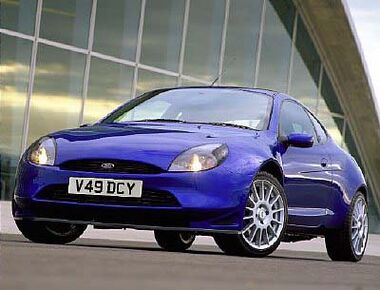
The Ford Racing Puma was the name eventually given to Ford's concept Puma, the Puma ST160 Concept, which was first unveiled to the public at the 1999 Geneva Motor Show.[7] At the time, Ford were keen to stress that this was no mere styling job and the idea was to transfer the know-how and technology learned directly from Ford Puma race and rally programmes to a road car. It was created by the Ford Rally specialist team at Boreham. The strictly limited production run was initially pencilled to run for 1000 units, with 500 destined for the German market, and 500 for the UK. All conversions were carried out by Tickford, Daventry UK.[8] In the end, only the 500 destined for the UK market were produced and sold.
Less than half of the 500 cars were actually sold directly to customers, with the vehicle's high price (£23,000 when new) often cited as a reason, as rival performance cars such as the Subaru Impreza (with an additional 50+ BHP/Turbo, four-wheel-drive and rallying pedigree) were being offered for a maximum of £21,000 with the optional Pro Drive pack. The lower than anticipated demand had Ford offering Racing Pumas to senior managers through their MRC scheme, which enabled cars to continue being registered and converted. The lack of demand when brand new has allowed it to maintain an increased value over the standard Puma due to its rarity.
Race braking system
For the Racing Puma, Ford partnered with Alcon Design to produce a 4-Piston Motorsport braking system. The Alcon Racing Front Brake calipers use 295 mm (11.6 in) x 28mm discs (253mm discs on the rear). These brakes are one of the defining attributes of the Racing Puma and they contribute significantly to enabling the standard 1,174 kg (2,588 lb) car to pull a substantial 1.1g+ of braking force in the dry.[9] This compares well to the normal Puma's ability to achieve 0.7g on regular, smaller, 258 mm (10.2 in) x 22 mm (0.9 in) brake discs and calipers.
Bodywork handling
The bodywork was beefed up with wider, lightweight aluminium front and steel rear overhangs; these covered a substantially widened track at both the front and rear, requiring longer drive shafts unique to the Racing Puma. A front aerodynamic air splitter and modified wider front bumper with sports grill were used. The wheels are MiM Speedline alloys, 17 x 7.5 in (with an ET28 Offset) and use 215/40 17 tyres (original fitment tyres were Michelin SXGT 215/40 R17), this increases the width from 1674 mm to 1770 mm. The S1600 rally Puma is just 35 mm wider than this.
The Racing Puma's suspension was developed and honed by Ford's specialist division at Boreham, Essex, and the cars' monocoque shell was originally designed to be Ford's WRC entrant. Stig Blomqvist spent months fine-tuning the car's handling to ensure its chassis dynamics where perfected. The wider track, uprated springs, dampers, and special geometry settings refined the car's cornering poise to another level beyond the standard car's already excellent handling. The upshot of the improved chassis finesse was a bias towards tracks, hence the car has a very firm ride.
All Racing Pumas left the factory painted metallic Imperial Blue to signify their special racing edition status. This colour was only used by Ford on a select range of cars such as the Ford Escort Cosworth and Mk.1 Ford Focus RS edition models. The colour was not available on the regular Pumas in the UK market.
Gearbox and optional limited-slip differential
The standard IB5 gearbox was strengthened on the Racing Puma in comparison to the standard models. It contains modified shafts, which have been shot peened to withstand the extra load placed upon them. This allowed a revised Power-train Control Module software to be used, allowing more power and torque to be used in lower gears.
Additionally, Ford Racing offered an optional limited-slip differential to enhance handling even further, only 75 customer cars actually came equipped with that option from factory, but since then, subsequent owners have been known to retrofit it.
FRP engine
The original design remit was to achieve 180 bhp using a 1.7-litre Zetec SE equipped with a turbocharger. However, due to spiralling project costs, this was not achieved and eventually the Racing Puma engineers were forced to keep their changes within a naturally aspirated engine. The majority of the engine remained unchanged from the 1.7 Zetec SE used in the standard Puma. Only the camshafts, air intake (with the unique edition number engraved on it), a specially tuned complete exhaust system by Janspeed, and a revised engine management software helped to increase power by 30 hp, reducing the 0-62 mph (100 km/h) time to 7.8 seconds.
Millennium
Years available: 1999(V) to 2000(X)
Quantity produced: 1000
Peak quantity registered with DVLA (UK): 899 (2001 Q4)
Quantity remaining registered with DVLA (UK): 325 (including 226 that are SORN) as of Q3 2021
The Ford Millennium Edition cars were produced to commemorate the Millennium Products Award from the Design Council[6] in 1999 for being 'The first Ford in Britain designed solely on computer and in record time.' The Millennium Edition Puma featured eye-catching Zinc Yellow paintwork, and an Alchemy Blue (dark/navy blue) leather interior with Recaro seats. A numbered badge and keyring were available upon purchase from Ford, but the cars were not automatically numbered.
The Ford Ka and Focus also received the same award, and were also produced in the same quantity and paintwork, but with black leather interiors.
Thunder
Years available: 2000(X) to 2002(52)
Quantity produced: 2000 (1000 each in Moondust Silver and Magnum Grey)
Peak quantity registered with DVLA (UK): 1908 (2002 Q4)
Quantity remaining registered with DVLA (UK): 649 (including 376 that are SORN) as of Q3 2021
These were among the final 2000 Pumas produced. Although Moondust Silver was available throughout the whole of the production run, Magnum Grey was only available on the Thunder Edition. All of the Thunder Editions featured a Midnight Black (dark grey) leather interior, a six-disc CD changer and multispoke alloy wheels similar to those featured on the Fiesta Zetec-S.
Puma Black
Years available: 2000(X) to 2001(51)
Quantity produced: 1600
Peak quantity registered with DVLA (UK): 1579 (2003 Q4)
Quantity remaining registered with DVLA (UK): 333 (including 229 that are SORN) as of Q3 2021
The Puma Black featured a Midnight Black (dark grey) leather interior, Panther Black paintwork, and Ford's F1-style alloy wheels. The original quantity of the Puma Black was meant to be only 1000, but as the edition proved to be popular, an additional 600 were produced.
Racing
Rallying
Ford produced a Ford Puma kit car, which was designed specifically for rallying. The Puma's technical details included a Zetec SE all-alloy engine with four cylinders and 16 valves at 1596 cm3, power over 200 bhp (150 kW) at 9000 rpm, front wheel drive via a Hewland six-speed sequential gearbox, limited slip differential, dynamic front suspension using MacPherson struts with adjustable spring platforms, Ford Racing rear trailing arm beam with adjustable dynamic suspension, Alcon front brakes with 355 mm (14.0 in) diameter ventilated discs using four-piston calipers, Alcon 260 mm (10 in) diameter solid disc rear brakes with two piston calipers, a welded steel safety roll cage, and front and rear wheel arches and bumpers in composite.
The fuel tank was a 55-litre capacity FIA ‘bag’ tank located beneath the rear floor. Wheels were Tarmac 7 x 17 in aluminium wheels or 6 x 15 in aluminium wheels for gravel.
Third generation (YYYY–YYYY)
Second generation (YYYY–YYYY)
First Generation/Origins (YYYY–YYYY)
Discontinuation
The Puma was only sold in Europe. Production ended in 2001, although sale of stock vehicles continued into 2002. Ford did not replace it with another small coupé, and instead introduced the Ford StreetKa, a two-seater convertible based on the Fiesta like the Puma was. The StreetKa also borrowed the Puma's transmission and suspension. There are 8,445 Ford Pumas (including cars declared as SORN) that remain registered with the DVLA in the UK as of Q3 2021.[3] However, the name was revived by Ford as a crossover model in 2019.
Design quirks and oddities
Refer to any pop-culture tidbits about the vehicle in this section.
Awards
List out notable awards that the model has recieved while in production. Boldface the company or orgainization that gives out the award, and Italicize the name of the award.
Film and television appearances
Cars
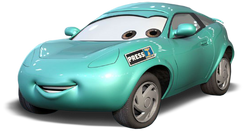
Kori Turbowitz
Kori Turbowitz (voiced by San Francisco Bay Area DJ Sarah Clark) is a 1997 Ford Puma; a news reporter who shows up in Cars three times.
See Also
| Ford cars made for the European market | ||
| Köln | Y | Rheinland | Eifel | C Ten | 7Y | 7W | Prefect | Anglia | Pilot | Zephyr | Consul | Squire | Taunus Vedette | Comète | Cortina | Popular | Classic | Corsair | Escort | Capri | Granada | Fiesta | Sierra | RS200 | Orion | Scorpio | Probe | Mondeo | Galaxy | Ka | Puma | Focus | Cougar | Maverick | Fusion | GT | Focus C-MAX | S-MAX | ||
| Edit this template | ||
External Links
Please include any external sites that were used in collaborating this data, including manufacturer sites, in this section.



